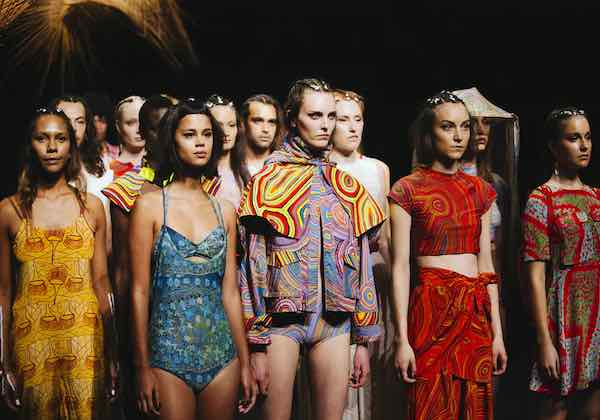This year’s Australian Fashion Week was full of firsts. For the first time in the event’s thirty-one-year history, it opened with a Welcome to Country and a traditional smoking ceremony performed by First Nations elders. It was also the first time a runway show staffed, modelled and designed entirely by Indigenous Australians was staged at the event, pioneered by the recently established initiative, ‘First Nations Fashion and Design.’ The integration of Australian history and culture into a much-anticipated – and Instagrammed – event like Fashion Week signalled a shift in the country’s fashion scene. Belated as it is, the presence of Indigenous creativity at the events made salient a sector of Australia’s fashion landscape that has gone unrecognised for far too long.
Indigenous culture has been at the forefront of innovation and sustainability since, well, forever. Now that the severe impacts of the fashion industry on the environment are well known, designers and brands are scrambling to develop environmentally-friendly practices to keep up with the zeitgeist – something Indigenous designers have always done. The increased focus on consciously crafted pieces that have minimal impact on the environment has thrown a spotlight on First Nations brands doing just that. Drawing upon traditional practices, natural resources, and cultural ties, designers of Aboriginal and Torres Strait Islander descent are redefining thoughtful fashion through pieces that acknowledge the resilience, intelligence, and beauty of their cultures.
At the heart of First Nations fashion is a reverence for the environment. For tens of thousands of years, Aboriginal and Torres Strait Islander communities have developed a profound understanding of the intricacies of Australia’s ecosystems and weather patterns. As a result, First Nations designers are acutely aware of the importance of collaborating with the environment.
This is particularly true of Sydney-based label Maara Collective. For the brand’s Resort ’20 collection, founder, designer, and Yuwaalaraay woman, Julie Shaw, collaborated with master-weavers from the Bula’bula Art Centre in the Northern Territory to create hats, bags, and jewellery.
Speaking to Vogue Australia last year, Shaw discussed the approach taken by master-weavers to create the pieces, emphasising that “everything comes directly from nature and is sourced sustainably.” The women harvested roots, leaves and bulbs to create natural dyes which were used to colour pandanus leaves before weaving. Shaw allowed the weavers autonomy in deciding the colours and weaving technique employed for each piece, saying she was “blown away not only by the beautiful design aesthetic, but how technically perfect (the pieces) were in construction.”
Techniques like those employed by the weavers are undoubtedly laborious and time-intensive, yet the craftmanship truly is inimitable. It is akin to the practices of haute couturiers in the ateliers of Paris, and should be lauded as such. What makes these methods especially valuable is the way they connect the artisans to their culture, and consequently, connect the wearers to the artisan’s culture. In the same way that rock carvings and dot paintings convey Dreamtime stories, the ancient dyeing and weaving techniques employed by Indigenous elders function as means of telling stories and nurturing connections to country.
The cultural significance of these methods, as well as their sustainability and ingenuity, are the gold standard for garment design and production in Australia. However, the Australian fashion industry has been slow to acknowledge the value of these practices and as a result, Indigenous-led brands have struggled to gain traction amidst the fast fashion-saturated market. Fortunately, artist, designer, and founder of First Nations Fashion and Design, Grace Lillian Lee, is shining a light on Indigenous creatives, opening the doors for young people in Australia’s fashion-scape.
A graduate of RMIT, Lee has been instrumental in raising the profile of First Nations artists and designers across the country through her staging of fashion performances, like the one seen at this year’s Australian Fashion Week. Collaborating with art centres in remote communities, Lee mentors young artists, helping them develop their work into wearable pieces whilst preserving ancient methods of textile production. Though Lee’s work has been successful in empowering Aboriginal and Torres Strait Islander designers to pursue careers in the creative space, it has also magnified the need for a greater Indigenous presence within Australia’s fashion landscape.
The environmentally-focused approach taken by Indigenous-led brands is largely absent from fashion design and production in Australia. The ‘take only what you need’ attitude that informs many of the collections produced by Aboriginal and Torres Strait Islander designers gets to the crux of fashion’s biggest issue: overproduction and wastage. The Australian Government’s Department of Agriculture, Water and Environment report that our country is the world’s second-highest consumer of textiles per person – something that can only be changed with an overhaul of our collective approach to clothing consumption.
As consumers, we have power to reform the Australian fashion industry. We can choose to exacerbate overconsumption by shopping from fast-fashion retailers, or we can support brands doing right by the environment, their workers, and their customers. Australia is fortunate to be home to a rich, unique, and complex culture that has been at the forefront of intelligent and sustainable consumption for over 60,000 years. Supporting the designers that are paying homage to this culture while thoughtfully crafting garments with minimal environmental ramifications is a no-brainer.





